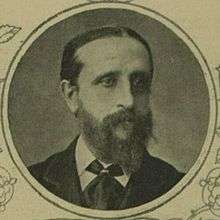Stalybridge by-election, 1905
The Stalybridge by-election was a Parliamentary by-election. It returned one Member of Parliament to the House of Commons of the United Kingdom, elected by the first past the post voting system.
Vacancy
The by-election was caused by the succession of the sitting Conservative MP, Matthew White Ridley to his father's viscountcy on 28 November 1904. Ridley had been MP for Stalybridge since the 1900 general election.
Electoral history
The seat had been Conservative since they gained it in 1885. They held the seat at the last election, with a reduced majority, the smallest majority since before they gained it;
| General Election 1900: Stalybridge[1] | |||||
|---|---|---|---|---|---|
| Party | Candidate | Votes | % | ±% | |
| Conservative | Baron Wensleydale, Matthew White Ridley | 3,321 | 50.6 | -4.5 | |
| Liberal | John Frederick Cheetham | 3,241 | 49.4 | +4.5 | |
| Majority | 80 | 1.2 | -9.0 | ||
| Turnout | 88.0 | -0.1 | |||
| Conservative hold | Swing | -4.5 | |||
Candidates
- The local Conservative Association selected 31-year-old James Travis Travis-Clegg as their candidate to defend the seat. He was standing for parliament for the first time. He was from Crompton, Lancashire. In 1898 he had been elected to Lancashire County Council.[2]
- The local Liberal Association re-selected 70-year-old John Frederick Cheetham who had been their candidate in 1900 when he had achieved a swing of 4.5%. Cheetham was born in Stalybridge, Cheshire, the eldest son of John Cheetham, a local cotton manufacturer who became a Member of Parliament for South Lancashire in 1852. Cheetham took over control of the family business, which employed 1,400 in two mills. He contested several elections before being returned as MP for North Derbyshire at the 1880 general election. He held that seat for five years, until the constituency was abolished at the 1885 general election, when he stood unsuccessfully in the new High Peak constituency. [3] He contested High Peak again in 1892,[3] and was also unsuccessful in Bury at the 1895 general election.[4]
Campaign
Although the vacancy was known on 28 November 1904 Polling Day was fixed for 7 January 1905.
Result
The Liberals gained the seat from the Conservatives;

| Stalybridge by-election, 1905[5] | |||||
|---|---|---|---|---|---|
| Party | Candidate | Votes | % | ±% | |
| Liberal | John Frederick Cheetham | 4,029 | 56.7 | +7.3 | |
| Conservative | James Travis Travis-Clegg | 3,078 | 43.3 | -7.3 | |
| Majority | 951 | 13.4 | 14.6 | ||
| Turnout | 7,601 | 93.5 | +5.5 | ||
| Liberal gain from Conservative | Swing | +7.3 | |||
Aftermath
At the following General Election Cheetham and Travis-Clegg faced each other again. The Liberal held onto he seat with a reduced majority;
| General Election 1906: Stalybridge[6] | |||||
|---|---|---|---|---|---|
| Party | Candidate | Votes | % | ±% | |
| Liberal | John Frederick Cheetham | 3,836 | 53.1 | -3.6 | |
| Conservative | James Travis Travis-Clegg | 3,382 | 46.9 | +3.6 | |
| Majority | 454 | 6.2 | -7.2 | ||
| Turnout | 93.8 | ||||
| Liberal hold | Swing | -3.6 | |||
See also
References
- ↑ British parliamentary election results, 1885-1918 (Craig)
- ↑ ‘TRAVIS-CLEGG, Sir James Travis’, Who Was Who, A & C Black, an imprint of Bloomsbury Publishing plc, 1920–2015; online edn, Oxford University Press, 2014 ; online edn, April 2014 accessed 8 April 2015
- 1 2 Craig, F. W. S. (1989) [1974]. British parliamentary election results 1885–1918 (2nd ed.). Chichester: Parliamentary Research Services. p. 249. ISBN 0-900178-27-2.
- ↑ Craig, British parliamentary election results 1885–1918, page 89
- ↑ British parliamentary election results 1885-1918 by Craig
- ↑ British parliamentary election results, 1885-1918 (Craig)
| ||||||||||||||||||||||||||||||